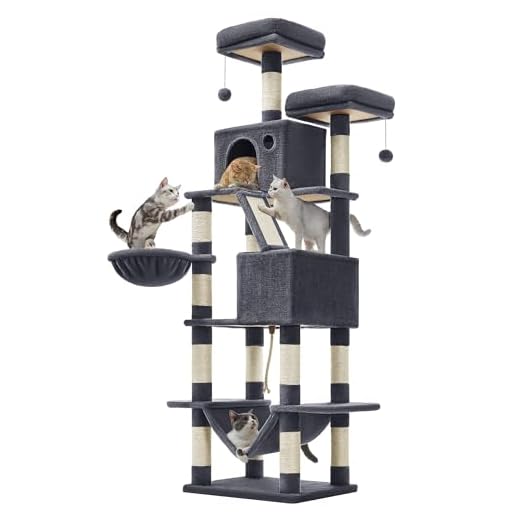


Begin with introductions in a controlled environment. Allow the small furry ones to explore the space where the larger companion resides. This way, they can get accustomed to each other’s scent and presence without direct interaction. It’s crucial to ensure the atmosphere is calm, as stress can hinder the initial meeting.
Offer treats to both animals simultaneously. This positive reinforcement helps associate each other’s presence with something pleasurable. Start with the smaller one in a carrier or behind a gate, gradually allowing closer proximity as they show interest and comfort. Patience is key; avoid rushing the process to prevent any negative experiences.
Utilise playtime as a bonding opportunity. Engage the playful spirit of the pup with toys while allowing the feline to observe. This encourages curiosity without forcing interaction. Over time, the small one might feel safe enough to join in the fun, easing any tension that may exist.
Be attentive to body language. Look for signs of relaxation, such as a lowered tail or soft eyes in both animals. If either of them appears anxious, take a step back and give them space. Gradual exposure fosters trust and comfort, laying the groundwork for a harmonious relationship.
Understanding Cat and Dog Behaviour
Recognising body language is vital. Cats communicate through subtle gestures. A relaxed cat will have its ears pointed forward, while a dog wagging its tail shows friendliness. Watch for signs of discomfort; a dog that barks or lunges can be feeling threatened. Similarly, a cat that hisses or swats indicates fear. Understanding these cues can prevent misunderstandings.
Playtime preferences differ. Dogs often enjoy vigorous play, while felines may prefer more solitary or gentle activities. Introduce interactive toys that engage both. A feather wand for the cat can interest the dog too, turning playtime into a shared experience. This encourages bonding through mutual enjoyment.
Feeding routines impact behaviours. Each species has unique eating habits. Cats tend to graze, while dogs might devour their meals quickly. Feeding them in separate areas helps reduce stress. If they see and smell each other while eating, it can lead to anxious behaviours. Gradually introducing them to each other during meal times can create positive associations.
Establishing safe spaces is crucial. Cats often seek high perches for security, while canines appreciate open areas. Providing vertical spaces for the cat, like shelves or cat trees, allows them to observe without feeling threatened. Dogs benefit from designated areas where they can retreat if feeling overwhelmed. This ensures both animals feel secure in their environment.
Socialisation plays a significant role. Early exposure to various animals helps both species adapt better. While it may be challenging to expose a young feline to canines, controlled introductions can help. Choose a calm dog that’s familiar with cats for initial meetings. This sets a positive precedent for future interactions.
Routine is comforting. Both species thrive on predictability. Maintain a consistent schedule for feeding, play, and rest. This creates stability, making interactions less stressful. When both animals understand their daily rhythm, they can interact more comfortably.
Patience is key. Building a rapport takes time. Regularly rewarding calm behaviour with treats or affection reinforces positive interactions. Eventually, you’ll notice a shift in dynamics as they become more comfortable around each other. Trust is built gradually, and it’s worth the effort for a harmonious household.
Positive Reinforcement Strategies for Building Trust
Start by associating your furry friend with delightful experiences. Use treats or favourite toys to create positive encounters when they share space. For instance, when the canine is calm around the feline, offer a tasty morsel. This reinforces the idea that peaceful coexistence brings rewards.
Creating Safe Spaces
Establish safe zones for both animals. This could be a designated area where the cat can retreat if feeling overwhelmed. Gradually introduce the dog to these spaces while rewarding calm behaviours. This approach helps the cat feel secure and less threatened, encouraging a more relaxed attitude towards the dog.
Controlled Introductions
Utilise leashes during initial meetings. Keep the dog on a lead while allowing the cat to approach at their own pace. If the dog remains calm and composed, reward them with praise or treats. This reinforces the behaviour you want to see, making interactions more pleasant for both parties. Remember, patience is key. For more insights into canine behaviour, check out this link on why does my dog want to bury his food.
Gradual exposure is crucial. Respect their individual personalities and allow them to set the pace. Over time, they’ll learn that each other’s presence can lead to positive outcomes, fostering a harmonious relationship.
Monitoring Interactions and Adjusting Approaches
Observe every encounter between the feline and canine. Pay attention to body language, vocalisations, and overall behaviour. A relaxed posture and playfulness from both parties indicate comfort, while growling, hissing, or tense movements signal distress.
Key Signs to Watch For
- Tail movements: A raised tail on a cat often shows confidence, while a low or puffed tail indicates fear.
- Ears: Forward-facing ears on both animals suggest curiosity; flattened ears denote discomfort.
- Vocal sounds: Soft purring or playful barking indicates positive interactions, while growling or hissing is a red flag.
Adjust interactions based on these observations. If one animal appears uncomfortable, take a step back. This might mean increasing the distance between them or providing a safe space for the pet feeling anxious.
Gradual Introduction Techniques
- Start with short, controlled meetings. Limit time together to avoid overwhelming either pet.
- Utilise barriers, such as baby gates, to allow them to see and smell one another without direct contact.
- Gradually reduce the distance over time as confidence builds.
- Incorporate playtime with toys that both can enjoy together, reinforcing positive feelings.
Regularly assess their comfort levels. If signs of stress persist, revert to earlier stages of introduction. Patience is crucial; rushing the process can hinder progress and create lasting negative associations. Consistently reward calm behaviour with treats or praise to encourage friendly interactions.







